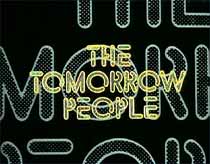 |
THE TOMORROW
PEOPLE
- SERIES ONE
A Guide to the
series on DVD
THE SLAVES OF JEDIKIAH
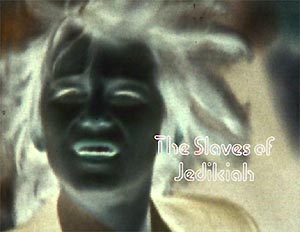 The
first story introduces the idea of a new superior race of human beings,
the homo superior - the so-called Tomorrow People, a group with
telepathic powers, and technology that enhances their ability to
"jaunt", a teleportation system regularly used in their fights
against the misguided forces of evil. The Tomorrow People have a secret
base in a disused London Underground tunnel, where they are aided by a
powerful talking biotronic computer, TIM. The Slaves of Jedikiah pits
the Tomorrow People against recurring nemesis Jedikiah, played with
obvious relish by Hammer regular Francis De Wolff. In the beginning there
were - at least as far as viewers were concerned - only three Tomorrow
People: John (the eldest, and their leader), Carol and 12-year old Kenny.
In this opening story they're joined by another, Stephen, who we witness
"breaking out", as he becomes aware of his supernatural powers. The
first story introduces the idea of a new superior race of human beings,
the homo superior - the so-called Tomorrow People, a group with
telepathic powers, and technology that enhances their ability to
"jaunt", a teleportation system regularly used in their fights
against the misguided forces of evil. The Tomorrow People have a secret
base in a disused London Underground tunnel, where they are aided by a
powerful talking biotronic computer, TIM. The Slaves of Jedikiah pits
the Tomorrow People against recurring nemesis Jedikiah, played with
obvious relish by Hammer regular Francis De Wolff. In the beginning there
were - at least as far as viewers were concerned - only three Tomorrow
People: John (the eldest, and their leader), Carol and 12-year old Kenny.
In this opening story they're joined by another, Stephen, who we witness
"breaking out", as he becomes aware of his supernatural powers.
This story also introduces Jedikiah's two henchmen: Lefty and Ginge, (who
change allegiance at the end of the story, to appear in both remaining
stories of the first season). The first episode of the story doesn't feature the famous 'opening
hand' title sequence (replete with Dudley Simpson's fabulous theme music),
and the story title, (which, like the writer's credit, usually punctuated
the main titles), appears over the end of a shot which turns into a
negative image (pictured). From the second episode onwards, the normal
main titles were used.
The
first and third stories of the opening season were directed by Paul
Bernard, who had three excellent Jon Pertwee Doctor Who stories to
his credit, including the landmark story Day of the Daleks, which
had made extensive use of the then-new and experimental CSO process
(a.k.a. Chromakey, the video equivalent of film's "greenscreen"
technique). Bernard was hired because his experience would help iron out
the inevitable technical problems the new series - the most
ambitious science fiction series tackled by any of the ITV companies -
would encounter.
Revelation
has chosen a slightly convoluted way of presenting the episodes. After the
first episode each subsequent episode originally began with a recap of the
events in the story so far, leading up to the title sequence. Although
these recaps have (wisely) been retained, they're only accessible from a
separate menu. This was probably a well-intentioned choice, designed to
make the story flow better as one episode leads quickly into the next, but
purists (the core market) would surely rather have had them attached to
the episode, with the option of a chapter marker at the end that would
make it easy to skip them if so desired. It's also unfortunate that Thames
- presumably - have added a modern logo' at the end of each episode
(thankfully the contemporary Thames animated opening sequence is
still there).
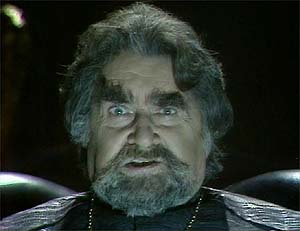 The
series was made as a mixture of video (for studio-based material) and 16mm
film (all the material shot on location). Like many contemporary series,
the film sequences are often in mediocre condition, exhibiting a constant
speckling of dirt, poor contrast and idiosyncratic and inconsistent colour
balance. Unless the original film negatives exist, there's not much that
can be done to improve this without exhaustive (expensive) labour
intensive restoration. Only the videotape recordings of The Tomorrow
People now exist, and so any film flaws that were present in the early
70s are now locked into Thames Television's masters, and these have been
transferred faithfully to Revelation's discs, warts 'n all. Picture
quality for this first disc is rather poor, exacerbated by Revelation's
misguided attempt to cram all five episodes (along with the commentary
track and other bonus materials) onto a single-layer disc. The result is
an image that's fuzzy throughout. Video sequences are often plagued by the
distinctive red and green highlights that are typical of PAL format
recordings (it's a result of high-frequency luminance information being
mistaken as colour information). The
series was made as a mixture of video (for studio-based material) and 16mm
film (all the material shot on location). Like many contemporary series,
the film sequences are often in mediocre condition, exhibiting a constant
speckling of dirt, poor contrast and idiosyncratic and inconsistent colour
balance. Unless the original film negatives exist, there's not much that
can be done to improve this without exhaustive (expensive) labour
intensive restoration. Only the videotape recordings of The Tomorrow
People now exist, and so any film flaws that were present in the early
70s are now locked into Thames Television's masters, and these have been
transferred faithfully to Revelation's discs, warts 'n all. Picture
quality for this first disc is rather poor, exacerbated by Revelation's
misguided attempt to cram all five episodes (along with the commentary
track and other bonus materials) onto a single-layer disc. The result is
an image that's fuzzy throughout. Video sequences are often plagued by the
distinctive red and green highlights that are typical of PAL format
recordings (it's a result of high-frequency luminance information being
mistaken as colour information).
THE
MEDUSA STRAIN
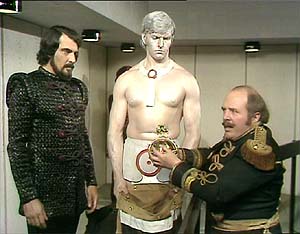 The
Medusa Strain,
a four-part story originally transmitted in June and July 1973, is more of
a romp than its predecessor. The story picks up more or less
where The Slaves of Jedikiah ended: after being defeated by the
Tomorrow People, Jedikiah is rescued by a passing spaceship, piloted by a
space pirate, in the year 2526. The portly pirate, Captain Rabowski, has
the ability to travel through time, thanks to a telepathic young boy
(played, incidentally, by Richard Speight, son of Till Death Us Do Part
creator Johnny Speight). Jedikiah and Rabowski plan to return to
Earth, in 1973, to steal the Crown Jewels, and plot to take revenge on the
Tomorrow People. The
Medusa Strain,
a four-part story originally transmitted in June and July 1973, is more of
a romp than its predecessor. The story picks up more or less
where The Slaves of Jedikiah ended: after being defeated by the
Tomorrow People, Jedikiah is rescued by a passing spaceship, piloted by a
space pirate, in the year 2526. The portly pirate, Captain Rabowski, has
the ability to travel through time, thanks to a telepathic young boy
(played, incidentally, by Richard Speight, son of Till Death Us Do Part
creator Johnny Speight). Jedikiah and Rabowski plan to return to
Earth, in 1973, to steal the Crown Jewels, and plot to take revenge on the
Tomorrow People.
The Medusa
Strain is a weak story, but it's helped by some imaginative direction
by Roger Price, who even manages to make an asset of the Spartan sets used
for Rabowski's ship. The story, now relatively
free of the cumbersome need to establish the premise of the series and its
characters, benefits greatly from a fast-moving plot. Critics would
doubtless say that it's a story that's pretty typical of the series,
featuring, as it does, the hilarious, Z-movie blob-like title creature, and Dave Prowse playing
Coffin, a
rather camp silver android, (providing the actor with a rare opportunity
for the actor to use his own, Bristol-accented voice).
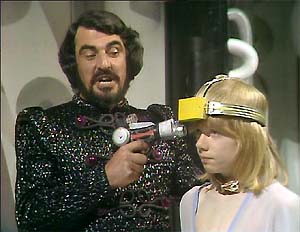 The
series' continuity is strengthened by a couple of casual comments about
the Tomorrow People, the extent of their powers, and the way that their
evolution will develop, but a throwaway line about a petty con-man from
the future who traveled back in time to become Adolf Hitler contradicts
the revelations in a much later story, Hitler's Last Secret. The
series' continuity is strengthened by a couple of casual comments about
the Tomorrow People, the extent of their powers, and the way that their
evolution will develop, but a throwaway line about a petty con-man from
the future who traveled back in time to become Adolf Hitler contradicts
the revelations in a much later story, Hitler's Last Secret.
Jedikiah's
ability to change shape allowed the producers to temporarily re-cast the
role of Jedikiah, who is now personified the significantly less
charismatic Roger Bizley, leaving the ham to be served by Roger Booth (who
plays Rabowski). It says a lot about the show's impoverished budget (and
about Price's skill as a writer) that the only other character in the
story is a Beefeater in the Tower of London vaults!
The disc comes with another fun commentary track
(by Nicholas Young, Philip Gilbert and Peter Vaughan-Clarke). As well as
the usual scathing comments about the show's production values, they
discuss their lives after the series ended (Young's career floundered, and
he became a theatrical agent, Vaughan-Clarke retired from acting and
became a lighting designer). The disc also contains the usual text-based
episode guides, production notes and cast profiles, as well as a good
Q&A-style interview with Young. There are fewer episodes this time around, but
any improvement in picture quality is marginal at best.
THE
VANISHING EARTH
The third Tomorrow
People story takes them out of their usual environment, and finds them
in a decidedly not sunny Clacton, where they discover an alien villain,
who has the power to influence the weather (scratchy stock footage ahoy!)
hiding in the labyrinth beneath a Haunted House ride.
The series' famously
low-budget production values are further undermined by an indifferent
transfer, which finds video sequences once again riddled with chroma noise
(something that processing with a decent PAL decoder would eliminate) and
an audio mix that seems unbalanced and phasey. The photo’ gallery
feature is now bolstered with pointless frame grabs. A jovial commentary
track completes the package. The Vanishing Earth disc refused
to load in my DVD-Rom drive, but worked in several standalone decks.
 The
Vanishing Earth benefits from a notable guest cast, including a couple
with impressive TV SF pedigrees. Kevin Stoney (the enigmatic Steen) had
been a memorable villain in two Doctor Who stories, pitted
against William Hartnell in The Daleks' Master Plan (1965-6)
and butting heads with Patrick Troughton in The Invasion (1968). He
also played the leader of an alien race in the 1975 Tom Baker story Revenge
of the Cybermen. Stoney
appeared in dozens of TV series, spanning four decades. Other TV credits
include The Adventures of Robin Hood, Doomwatch (The
Plastic Eaters), The Avengers (Mission... Highly Improbable),
Space:1999 (The Last Enemy), two episodes of Blake's 7 (Hostage
and Animals) and The Prisoner (The Chimes of Big Ben).
He also appeared in several episodes of Bergerac, playing 'Horatio'
Nelson, and played the Prime Minister in the 1979 Euston Films version of Quatermass.
John Woodnutt (Spidron) was another actor who had appeared alongside three
different Doctors in Doctor Who, including playing a couple of
roles in the early Tom Baker story Terror of the Zygons. He also
had an impressive range of credits, often playing Doctors and butlers, in
series like The Sweeney (Stay Lucky, Eh?), The Adventures
of Sherlock Holmes (The Red-Headed League), Children of the
Stones and The Avengers (Quick-Quick Slow Death). He
also appeared in several episodes of the Hugh Laurie and Stephen Fry
adaptation of Jeeves and Wooster, as Sir Watkyn. The
Vanishing Earth benefits from a notable guest cast, including a couple
with impressive TV SF pedigrees. Kevin Stoney (the enigmatic Steen) had
been a memorable villain in two Doctor Who stories, pitted
against William Hartnell in The Daleks' Master Plan (1965-6)
and butting heads with Patrick Troughton in The Invasion (1968). He
also played the leader of an alien race in the 1975 Tom Baker story Revenge
of the Cybermen. Stoney
appeared in dozens of TV series, spanning four decades. Other TV credits
include The Adventures of Robin Hood, Doomwatch (The
Plastic Eaters), The Avengers (Mission... Highly Improbable),
Space:1999 (The Last Enemy), two episodes of Blake's 7 (Hostage
and Animals) and The Prisoner (The Chimes of Big Ben).
He also appeared in several episodes of Bergerac, playing 'Horatio'
Nelson, and played the Prime Minister in the 1979 Euston Films version of Quatermass.
John Woodnutt (Spidron) was another actor who had appeared alongside three
different Doctors in Doctor Who, including playing a couple of
roles in the early Tom Baker story Terror of the Zygons. He also
had an impressive range of credits, often playing Doctors and butlers, in
series like The Sweeney (Stay Lucky, Eh?), The Adventures
of Sherlock Holmes (The Red-Headed League), Children of the
Stones and The Avengers (Quick-Quick Slow Death). He
also appeared in several episodes of the Hugh Laurie and Stephen Fry
adaptation of Jeeves and Wooster, as Sir Watkyn.
Go
to:
INTRODUCTION
SERIES
2 EPISODE GUIDE
|



 The
first story introduces the idea of a new superior race of human beings,
the homo superior - the so-called Tomorrow People, a group with
telepathic powers, and technology that enhances their ability to
"jaunt", a teleportation system regularly used in their fights
against the misguided forces of evil. The Tomorrow People have a secret
base in a disused London Underground tunnel, where they are aided by a
powerful talking biotronic computer, TIM. The Slaves of Jedikiah pits
the Tomorrow People against recurring nemesis Jedikiah, played with
obvious relish by Hammer regular Francis De Wolff. In the beginning there
were - at least as far as viewers were concerned - only three Tomorrow
People: John (the eldest, and their leader), Carol and 12-year old Kenny.
In this opening story they're joined by another, Stephen, who we witness
"breaking out", as he becomes aware of his supernatural powers.
The
first story introduces the idea of a new superior race of human beings,
the homo superior - the so-called Tomorrow People, a group with
telepathic powers, and technology that enhances their ability to
"jaunt", a teleportation system regularly used in their fights
against the misguided forces of evil. The Tomorrow People have a secret
base in a disused London Underground tunnel, where they are aided by a
powerful talking biotronic computer, TIM. The Slaves of Jedikiah pits
the Tomorrow People against recurring nemesis Jedikiah, played with
obvious relish by Hammer regular Francis De Wolff. In the beginning there
were - at least as far as viewers were concerned - only three Tomorrow
People: John (the eldest, and their leader), Carol and 12-year old Kenny.
In this opening story they're joined by another, Stephen, who we witness
"breaking out", as he becomes aware of his supernatural powers.  The
series was made as a mixture of video (for studio-based material) and 16mm
film (all the material shot on location). Like many contemporary series,
the film sequences are often in mediocre condition, exhibiting a constant
speckling of dirt, poor contrast and idiosyncratic and inconsistent colour
balance. Unless the original film negatives exist, there's not much that
can be done to improve this without exhaustive (expensive) labour
intensive restoration. Only the videotape recordings of The Tomorrow
People now exist, and so any film flaws that were present in the early
70s are now locked into Thames Television's masters, and these have been
transferred faithfully to Revelation's discs, warts 'n all. Picture
quality for this first disc is rather poor, exacerbated by Revelation's
misguided attempt to cram all five episodes (along with the commentary
track and other bonus materials) onto a single-layer disc. The result is
an image that's fuzzy throughout. Video sequences are often plagued by the
distinctive red and green highlights that are typical of PAL format
recordings (it's a result of high-frequency luminance information being
mistaken as colour information).
The
series was made as a mixture of video (for studio-based material) and 16mm
film (all the material shot on location). Like many contemporary series,
the film sequences are often in mediocre condition, exhibiting a constant
speckling of dirt, poor contrast and idiosyncratic and inconsistent colour
balance. Unless the original film negatives exist, there's not much that
can be done to improve this without exhaustive (expensive) labour
intensive restoration. Only the videotape recordings of The Tomorrow
People now exist, and so any film flaws that were present in the early
70s are now locked into Thames Television's masters, and these have been
transferred faithfully to Revelation's discs, warts 'n all. Picture
quality for this first disc is rather poor, exacerbated by Revelation's
misguided attempt to cram all five episodes (along with the commentary
track and other bonus materials) onto a single-layer disc. The result is
an image that's fuzzy throughout. Video sequences are often plagued by the
distinctive red and green highlights that are typical of PAL format
recordings (it's a result of high-frequency luminance information being
mistaken as colour information). The
Medusa Strain
The
Medusa Strain The
series' continuity is strengthened by a couple of casual comments about
the Tomorrow People, the extent of their powers, and the way that their
evolution will develop, but a throwaway line about a petty con-man from
the future who traveled back in time to become Adolf Hitler contradicts
the revelations in a much later story, Hitler's Last Secret.
The
series' continuity is strengthened by a couple of casual comments about
the Tomorrow People, the extent of their powers, and the way that their
evolution will develop, but a throwaway line about a petty con-man from
the future who traveled back in time to become Adolf Hitler contradicts
the revelations in a much later story, Hitler's Last Secret.  The
Vanishing Earth benefits from a notable guest cast, including a couple
with impressive TV SF pedigrees. Kevin Stoney (the enigmatic Steen) had
been a memorable villain in two Doctor Who stories, pitted
against William Hartnell in The Daleks' Master Plan (1965-6)
and butting heads with Patrick Troughton in The Invasion (1968). He
also played the leader of an alien race in the 1975 Tom Baker story Revenge
of the Cybermen.
The
Vanishing Earth benefits from a notable guest cast, including a couple
with impressive TV SF pedigrees. Kevin Stoney (the enigmatic Steen) had
been a memorable villain in two Doctor Who stories, pitted
against William Hartnell in The Daleks' Master Plan (1965-6)
and butting heads with Patrick Troughton in The Invasion (1968). He
also played the leader of an alien race in the 1975 Tom Baker story Revenge
of the Cybermen.